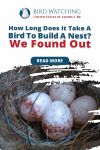
What’s This Post About?
Northern cardinals are listed as the most recognized bird species of Northern America. This is because of their distinctive features, such as the bright red body with a crest on the head and a black mask imprinted on the face.
The northern cardinal is a non-migratory bird and may stay in the same area throughout the year. They tend to settle in places that consist of a good source of food, water, and shelter.
Keep reading to know more about northern cardinals, their habitat, and how they raise the young.
Cardinals produce 1 to 3 broods per season and each brood consists of 2 to 5 eggs. This means that annually, northern cardinals produce approximately 8 to 12 broods with 24 to 60 eggs. Each egg weighs approximately 4.5 grams with a 0.9-1.1 inches length and 0.7-0.8 inches width.

How to Distinguish Northern Cardinals from Other Birds?
Some basic description, lifestyle, and behavioral patterns of northern cardinals.

Northern cardinals are a symbol of familiarity and style. The distinctive features such as the shades of red on them create a mesmerizing experience for the viewer. The male northern cardinal has brighter shades of red on its body while the female northern cardinal is of a brown tone with streaks of warm red.
Northern cardinals do not migrate hence, they are present in all seasons. They add to the beauty of the snowy winters and their sweet whistles in the summer make the morning merrier.
Behavioral Patterns of Cardinals
Cardinals mostly perch on low branches and prefer feeding off the ground. Their crest raises in times of high alert or restlessness and is lowered when they are resting.
Cardinals are usually seen in pairs during breeding seasons but during the fall or winter season, they move around in flocks to search for food collectively.
Fun Fact
Flocks of cardinals are also called a deck, college, vatican, or radiance of cardinals.
Common Call of Cardinals
Both male and female northern cardinals can sing, unlike other songbirds in North America. They can sing up to 28 different phrases with varying tones in each.
The male cardinal usually perches at the top of a building, tree, or roof then sings to attract females to mate. Female cardinals sing from the nest to tell the male cardinal that she needs food.
Pro-Tip
If you hear a sweet chirping noise of a cardinal, try to look at the highest tree, wire, or building near you since the cardinals choose high perches to sing.

Molting Season
Northern cardinals do not migrate and stay within the same area throughout the year. This makes it crucial for them to adapt to the changing seasons. For them to adapt, they go through a molting period.
To adapt to the cold winters, northern cardinals grow an extra layer of feathers to keep them warm. During the summer season, the birds molt their feathers and grow new feathers in the late summers or early fall season.
The molting process is what protects them from extreme cold and hot weather, making it easy for them to survive without migrating.
Interesting Fact
Due to the unusual molting periods, northern cardinals may go bald till they grow new feathers on their head.
How Do Northern Cardinals Nest?
Are cardinals’ good parents? To learn more about their mating and nesting decisions keep on reading!
Two weeks before the nest building process starts, the female cardinals go around and look for potential places along with the male. The nest is usually built in dense shrubby areas that they believe to be secure and well hidden.

The Mating Process
The mating process for northern cardinals takes place in March, May, June, and July. When a male is attracted to a female cardinal, they express love by feeding them seeds from their beaks. The method is called ‘beak to beak’.
The male cardinals are aggressive when it comes to defending their nests. They sing to protect their territory and will also attack other intruders.
The courtship is where the male and female express affection towards each other. During courtship, both the cardinals raise their heads and sing softly.
The male cardinal often provides food to the female cardinals when she sings from the nest asking for food.
Nest Building
Female cardinals are responsible for building the nest, while male cardinals are responsible for bringing the nesting material to them.
Nesting materials include:
- Grass
- Small bark strips
- Twigs and leaves
- Rootlets
- Animal fur
They use these materials to build a nest on different kinds of trees and shrubs. Some common examples. Preferred by northern cardinals, are:
- Honeysuckle
- Hawthorn
- Grape
- Sugar maples
- Rose bushes
- Pines and spruce
The female cardinal then utilizes these materials. She crushes and molds the materials with her beak and feet in the shape of a cup.
The base of the nest is created with twigs and is then covered with grass, rootlets, and stems. It takes up to 9 days for the nest to be built.
Pro-Tip
If you want to attract northern cardinals to your backyard as permanent residents, you need to make sure that your yard is filled with dense trees and shrubs.
How to Identify A Northern Cardinal’s Eggs?
Every bird species has a different type of egg. They may differ in shape, size, and color. to identify a northern cardinal’s egg, you should know of the following information.

A northern cardinal’s egg has a smooth and glossy outer with small patches of green, brown, gray, and blue. The egg is usually 2.2 to 2.7 centimeters long and 1.7 to 2 centimeters wide.
The incubation period is of 11 to 13 days. From the time they are hatched to the time they are 2 months old; the young cardinals are fed by both their parents.
The young birds survive on insects and spiders till they learn to feed themselves. The male cardinal takes care of the food needs while the female cardinal sets off to build a new nest and lay more eggs.
Interesting Fact
The female northern cardinal only lays up to five eggs in one nest then creates another nest to lay more!
What Are the Different Stages of The Newly Born Birds?
The young birds go through three different stages till they become independent.

The young northern cardinals are fed and raised by their parents till they become fully capable of feeding themselves. To reach independence they go through three stages: 0 to 3 days old, 4 to 13 days old, 14 days, and older.
Stage 1
At this stage, the young bird is 0 to 3 days old. The birds at this stage have newly hatched and do not have any feathers on their naked bodies.
Their eyes are closed, and they cannot move or walk on their own, requiring care and protection.
Stage 2
At this stage, the birds are 4 to 13 days old and are known as nestlings. The nestlings can open their eyes and have feathers on their wings.
They begin to develop a brownish rusty color on their feathers but are still not ready to leave the nest.
Stage 3
14 days and older, the nestlings can now be called fledglings. At this point, they are fully feathering and in process of developing a crest.
The fledgling’s beak at this stage is black but as they grow older, they will develop a reddish shade.
The fledglings cannot fly yet, they can walk and hop around. They may leave the nest only with the assistance of their parents. After stage 3, within 20 days, the fledgling will be ready to leave the nest.
If you are interested to watch these beautiful creatures’ nests in your yard, you can hang up cardinal feeders and birdbaths all over to attract them to stay.
Bench Wooden Bird Feeder
A solid wood smell is like well treat that attracts different kinds of birds
Keep Reading!
The northern cardinals are attractive birds and may be welcomed by many in their backyards. This post consists of all the information required to know about a northern cardinal and the different processes they go through to grow in numbers.
With the help of the pro-tips mentioned, you can attract these birds to your place and provide a comfortable and welcoming environment for them.
If you have a newly developed interest in birds and are clueless on how to install the birdbaths in your backyard, read our posts.
5 Easy Steps to Install a Bird Bath: Security, Position, Height, and More Tips!
Install a birdbath today and make your lawn, a bird’s gorgeous looking, favorite rest spot. Read more about this garden accessory now!

By David A. Swanson
Bird Watching USA
My name is David and I'm the the founder of Bird Watching USA! I started Bird Watching with My father-in-law many years ago, and I've become an addict to watching these beautiful creatures. I've learnt so much over about bird watching over the years that I want to share with the world everything I know about them!

David A. Swanson
Bird Watching USA
My name is David and I'm the the founder of Bird Watching USA! I started Bird Watching with My father-in-law many years ago, and I've become an addict to watching these beautiful creatures. I've learnt so much over about bird watching over the years that I want to share with the world everything I know about them!











